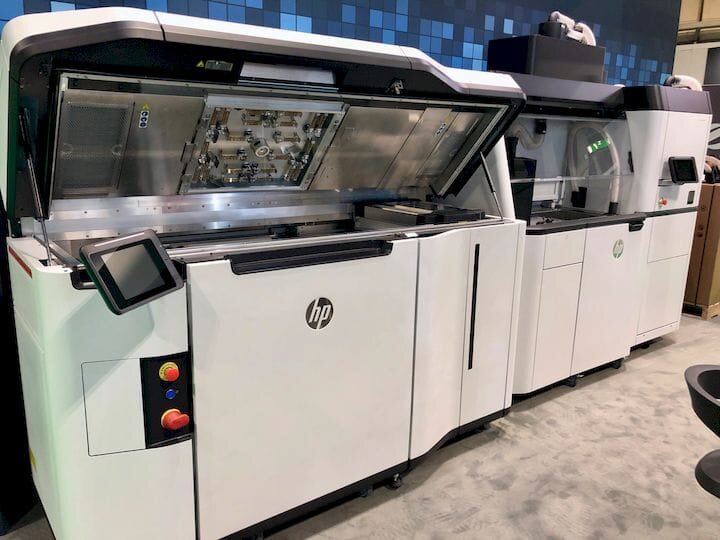![HP 3D printing equipment [Source: Fabbaloo]](https://fabbaloo.com/wp-content/uploads/2020/05/image-asset_img_5eb08d2970587.jpg)
HP announced today a series of moves to boost their rapidly expanding 3D printing business.
The highlight of their announcement was “HP 3D as a Service”, or “3DaaS”. This is a subscription service for use of HP MJF equipment that covers HP-related costs. There are two forms of 3DaaS.
HP 3D Printing Subscription
The “Base” 3DaaS is a service designed for those who already own HP 3D printing gear. It covers the costs of consumables and support services, which would be invoiced as a single subscription service. 3DaaS Base will track usage of materials and generate a “pay-per-build” charge that would be added to the monthly invoice. This service will allow a company using MJF technology to simplify operations somewhat, as the system will do some of the administrative work that would otherwise have to be done by operators.
There’s another subscription that’s more interesting: 3DaaS Plus. This includes not only the basic materials and support services of the base subscription, but adds hardware integration. In other words, it sounds like you could very quickly get going with HP 3D printing equipment without having to lay out big cash for acquiring the equipment itself. Instead, you’d pay by subscription for the entire package of HP hardware, software, consumables and service.
The 3DaaS Plus service seems much like a lease, where no capital is paid up front, and the customer simply pays a monthly amount. But in this case the amount is variable because it includes an additional financial component related to the amount of printing that takes place.
3DaaS Acceptance?
I suspect many corporate clients would very much prefer this form of business model, as it relieves them from the financial burden of finding acquisition capital. That’s often quite challenging in large companies because large capital numbers attract unwanted attention from those above in the management hierarchy, and it’s often easier to slide a much smaller monthly payment into the budget.
It’s for this reason some companies lease equipment even though that is, in the long run, more expensive to do. HP is attempting to capitalize on this effect and they should be successful. It should be very interesting to see how the market perceives this new offering.
HP also announced new members to their expanding HP Digital Manufacturing Network, a consortium of 3D print services worldwide that offer MJF technology to business. The new members include Prototal in Europe and Solize in Japan. It’s not clear how many players are now in the HP network, but it seems to be growing constantly.
[UPDATE] HP informs us they currently have nine members in the network, including:
-
Forecast 3D
-
Jabil
-
Prototal
-
GKN Powder Metallurgy
-
Materialise
-
Solize
-
GoProto
-
Parmatech
-
ZiggZagg NV
HP 3D Printing Technical Developments
On the technical side, HP’s collaboration with Siemens at the Siemens Additive Manufacturing Experience Center was used by EDAG Inc., a well-known designer of high-end automotive parts, to develop an advanced active coolant distributor for an EV. This part’s design process used topology optimization, and demonstrates the value of a competency center such as the Siemens facility, where clients can get access to expertise, equipment and materials to perform additive manufacturing experiments.
One of HP’s materials partners, Lubrizol, a noted chemical company, has developed a new flexible TPU material for use in HP 4200 equipment. This is an example of HP’s materials partner program, which helps third parties develop unusual materials for use with HP’s MJF technology.
Finally, HP has struck a deal with AM Solutions to provide automated surface finishing services for parts produced on HP equipment. The partnership provides for a simplified post-processing workflow for operators.
HP 3D Printing Growth
That’s quite a bit of news from HP, and it shows the company continues to drive their technology very hard. HP says in the last 12 months their equipment has produced more than 18M parts. If that isn’t production volumes, I don’t know what is.
It’s been a long journey for HP to get to this point. I first saw their experimental forays into 3D printing years ago when they became, for a time, a reseller of Stratasys equipment. But after learning about the industry they went back to their labs and developed their own 3D printing process.
It was years before they launched it, but now that it’s been out for a few years it has really taken hold and is being used extensively by many clients.
Via HP

